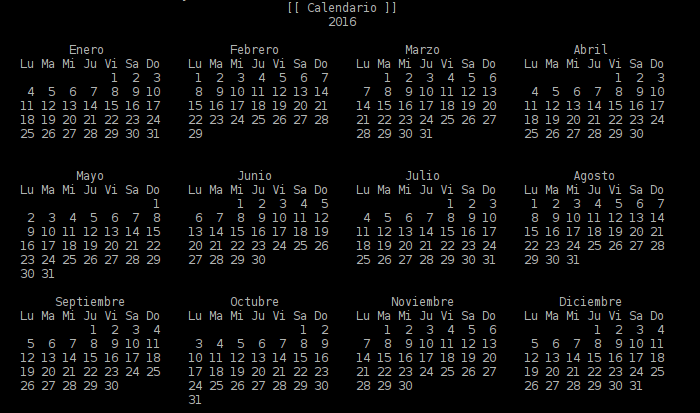Calendario anual
Java
Publicado el 9 de Agosto del 2016 por Xve (294 códigos)
27.851 visualizaciones desde el 9 de Agosto del 2016
Esta clase muestra el calendario del año que desees con la cantidad de meses por fila








 (7)
(7)














import java.text.*;
import java.util.*;
public class Calendario {public static void main(String[] args) {
printCalendar(2016, 4);
}static void printCalendar(int year, int nCols) {
if (nCols < 1 || nCols > 12)
throw new IllegalArgumentException("Numero de columnas incorrecto!!");
Calendar date = new GregorianCalendar(year, 0, 1);
int nRows = (int) Math.ceil(12.0 / nCols);
int offs = date.get(Calendar.DAY_OF_WEEK) - 2;
int w = nCols * 24;
String[] monthNames = {"Enero", "Febrero", "Marzo", "Abril", "Mayo", "Junio", "Julio", "Agosto", "Septiembre", "Octubre", "Noviembre", "Diciembre"};
String[][] mons = new String[12][8];
for (int m = 0; m < 12; m++) {
String name = monthNames[m];
int len = 11 + name.length() / 2;
String format = MessageFormat.format("%{0}s%{1}s", len, 21 - len);
mons[m][0] = String.format(format, name, "");
mons[m][1] = " Lu Ma Mi Ju Vi Sa Do";
int dim = date.getActualMaximum(Calendar.DAY_OF_MONTH);
for (int d = 1; d < 43; d++) {
boolean isDay = d > offs && d <= offs + dim;
String entry = isDay ? String.format(" %2s", d - offs) : " ";
if (d % 7 == 1)
mons[m][2 + (d - 1) / 7] = entry;
else
mons[m][2 + (d - 1) / 7] += entry;
}offs = (offs + dim) % 7;
date.add(Calendar.MONTH, 1);
}System.out.printf("%" + (w / 2 + 10) + "s%n", "[[ Calendario ]]");
System.out.printf("%" + (w / 2 + 4) + "s%n%n", year);
for (int r = 0; r < nRows; r++) {
for (int i = 0; i < 8; i++) {
for (int c = r * nCols; c < (r + 1) * nCols && c < 12; c++)
System.out.printf(" %s", mons[c][i]);
System.out.println();
}System.out.println();
} }}
Comentarios sobre la versión: Versión 1 (7)
printCalendar(2017, 10);
ver calendario comp. y tambien tenga la opcion de pedir el mes te lo agradeceria mucho